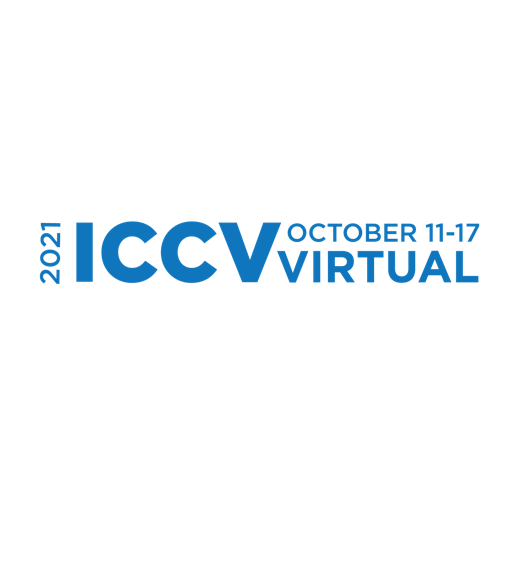
iccv 1993 论文列表Fourth International Conference on Computer Vision, ICCV 1993, Berlin, Germany, 11-14 May, 1993, Proceedings. |
Dynamic calibration of an active stereo head.
Grasping visual symmetry.
The critical sets of lines for camera displacement estimation: A mixed Euclidean-projective and constructive approach.
Egomotion analysis based on the Frenet-Serret motion model.
A global algorithm for shape from shading.
Shape from texture from a multi-scale perspective.
Linear and incremental acquisition of invariant shape models from image sequences.
Probabilistic relaxation for matching problems in computer vision.
An improved algorithm for algebraic curve and surface fitting.
Large deformable splines, crest lines and matching.
Integration of quantitative and qualitative techniques for deformable model fitting from orthographic, perspective, and stereo projections.
Quantitative analysis of the viewpoint consistency constraint in model-based vision.
Multiple knowledge sources and evidential reasoning for shape recognition.
Active and intelligent sensing of road obstacles: Application to the European Eureka-PROMETHEUS project.
An all-transputer visual autobahn-autopilot/copilot.
Renormalization for unbiased estimation.
Computation of ego-motion and structure from visual and inertial sensors using the vertical cue.
Projective depth: A geometric invariant for 3D reconstruction from two perspective/orthographic views and for visual recognition.
Extracting projective structure from single perspective views of 3D point sets.
Robust 3D-3D pose estimation.
A robust active contour model with insensitive parameters.
2-D digital curve analysis: A regularity measure.
Occam algorithms for computing visual motion.
Robust line-based pose enumeration from a single image.
Relative 3D positioning and 3D convex hull computation from a weakly calibrated stereo pair.
Optimal estimation of object pose from a single perspective view.
Accurate line parameters from an optimising Hough Transform for vanishing point detection.
Surface discontinuities in range images.
A finite element model for 3D shape reconstruction and nonrigid motion tracking.
Minimum description length based 2D shape description.
A note on existence and uniqueness in shape from shading.
Cooperation of visually guided behaviors.
Interpretation of natural scenes using multi-parameter default models and qualitative constraints.
Using hyperquadrics for shape recovery from range data.
Distance accumulation and planar curvature.
Relative depth from vergence micromovements.
Recognizing algebraic surfaces from their outlines.
Projectively invariant decomposition and recognition of planar shapes.
Euclidean constraints for uncalibrated reconstruction.
Texture discrimination by local generalized symmetry.
A system for automatic vectorization and interpretation of map-drawings.
Sergey Ablameyko Vladimir Bereishik Oleg Frantskevich Maria Homenko E. Melnik Oleg Okun Nadeshda Paramonova
Direct estimation of multiple disparities for transparent multiple surfaces in binocular stereo.
A complete two-plane camera calibration method and experimental comparisons.
A binocular stereo algorithm for reconstructing sloping, creased, and broken surfaces in the presence of half-occlusion.
Stereo matching, reconstruction and refinement of 3D curves using deformable contours.
Dynamic fixation [active vision].
Reactions to peripheral image motion using a head/eye platform.
Head-centered orientation strategies in animate vision.
Robust vergence with concurrent detection of occlusion and specular highlights.
Robust structure from motion using motion parallax.
Motion segmentation and local structure.
Combining stereo and motion analysis for direct estimation of scene structure.
Exploiting the generic view assumption to estimate scene parameters.
Eliciting qualitative structure from image curve deformations.
Automatic feature point extraction and tracking in image sequences for unknown camera motion.
The reciprocal-wedge transform for space-invariant sensing.
Understanding noise: The critical role of motion error in scene reconstruction.
Recognizing mice, vegetables and hand printed characters based on implicit polynomials, invariants and Bayesian methods.
Incremental image sequence enhancement with implicit motion compensation.
A modal framework for correspondence and description.
Recognition of object classes from range data.
Learning object recognition models from images.
A linear complexity procedure for labelling line drawings of polyhedral scenes using vanishing points.
Contextual feature similarities for model-based object recognition.
Reflectance ratio: A photometric invariant for object recognition.
Fast segmentation, tracking, and analysis of deformable objects.
Silhouette-based object recognition through curvature scale space.
3D object recognition by indexing structural invariants from multiple views.
A perceptually plausible model for global symmetry detection.
Multiscale Markov random field models for parallel image classification.
A quantitative methodology for analyzing the performance of detection algorithms.
Building and using flexible models incorporating grey-level information.
A design for a visual motion transducer.
A framework for the robust estimation of optical flow.
Localization using combinations of model views.
Visual echo analysis.
Mathematical morphology: The Hamilton-Jacobi connection.
Optical flow from 1D correlation: Application to a simple time-to-crash detector.
Discrete models for energy-minimizing segmentation.
Segmentation and 2D motion estimation by region fragments.
An extension of Marr's signature based edge classification and other methods determining diffuseness and height of edges, and bar edge width.
Enhanced image capture through fusion.
Diagonal transforms suffice for color constancy.
Recovering reflectance and illumination in a world of painted polyhedra.
Estimation of the light source distribution and its use in integrated shape recovery from stereo and shading.
Diffuse shading, visibility fields, and the geometry of ambient light.
Vision-based construction of CAD models from range images.
Learning recognition and segmentation of 3-D objects from 2-D images.
Fast and robust 3D recognition by alignment.
A spherical representation for the recognition of curved objects.
Tracking non-rigid objects in complex scenes.
Experiments with monocular visual tracking and environment modeling.
Tracking foveated corner clusters using affine structure.
Affine-invariant contour tracking with automatic control of spatiotemporal scale.
Ridge-detection for the perceptual organization without edges.
Looking for trouble: Using causal semantics to direct focus of attention.
Active exploration: Knowing when we're wrong.
A computational model of neural contour processing: Figure-ground segregation and illusory contours.
Motion detection robust to perturbations: A statistical regularization and temporal integration framework.
Robust computation of optical flow in a multi-scale differential framework.
A generalized brightness change model for computing optical flow.

